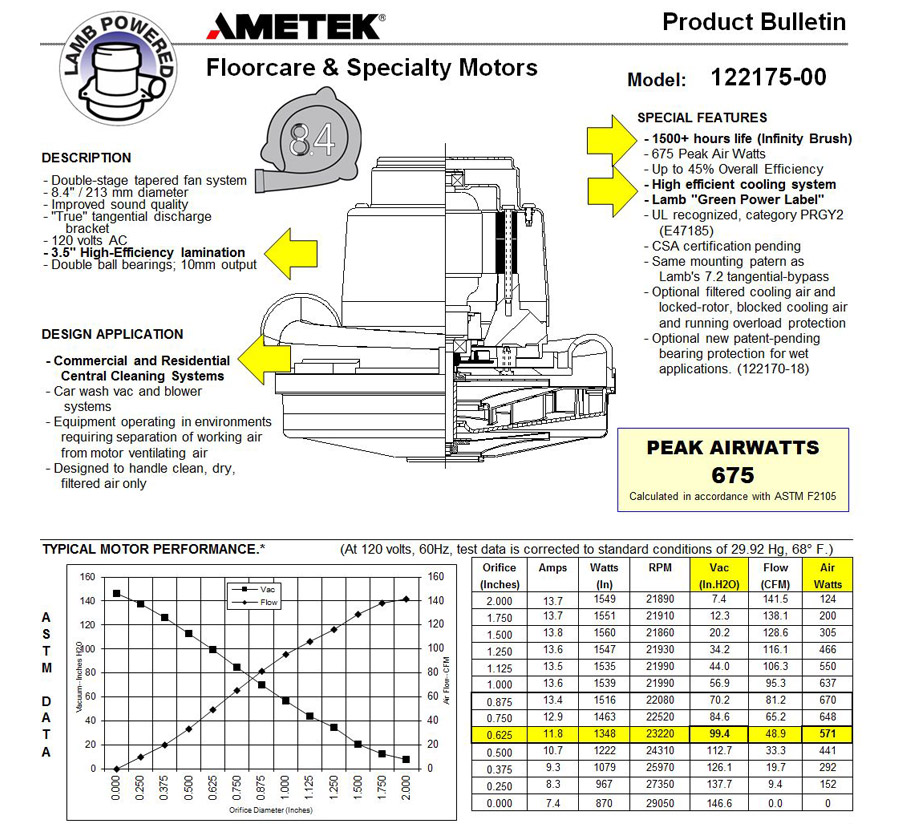Central Vacuum Buyer’s Guide
Make an informative purchasing decision.
Airwatts
Now that we have discussed the motor – the most important part of your central vacuum system, let’s familiarize you with some commonly used industry terms.
The performance numbers you see in a product brochure often mean little in an actual home installation. Unfortunately however, consumers know very little about the differences in central vacuum motors. Instead, they rely on performance numbers such as Airwatts as a basis for their central vacuum comparison.
If there’s anything you take away from our buyer’s guide to help you make the choice on value, you should:
(1) ALWAYS compare motors
(2) NEVER base your buying decision on “AIRWATTS”
In principle, Airwatts measures the “sweet spot” at which Suction and Airflow are at their best at a particular orifice size. It’s calculated using the following mathematical formula: Suction (at orifice) x Airflow (at orifice) divided by 8.5.
However, the problem with relying on this formula is that it’s taken directly at the motor without any restrictions such as filtration, airflow loss due to the PVC plumbing, and pressure losses within a typical central vacuum installation.
In fact, the only way that Airwatts would be an accurate measurement of system performance is if the calculation was made at the end of the vacuum hose!
So, does that mean that a system with higher Airwatts would still perform better than another system with lesser Airwatts? The answer is….it depends on the Suction and Airflow at the “effective working orifice”.
Ametek/Lamb engineers have determined that the “effective working orifice” (the orifice at which a typical central vacuum operates in a ‘typical installation’ and factors in performance robbing restrictions) is on average around the orifice of 5/8 inches (.625 inches).
This revelation changes the Airwatt numbers completely from what you see in a brochure.
For those of you who want even more detail on this subject, the following information is from two Ametek/Lamb motor performance bulletins:

Figure 1
Is a 5.7” Thru-Flow 2-Stage motor with 700 ‘Peak Airwatts” (The number you would see published in a product brochure).

Figure 2
Is a premium 1-Stage motor heavy duty commercial rated 8.4” Tangential Bypass motor with 717 ‘Peak Airwatts’ (The brochure number).
The first thing you should notice is that Brochure Airwatts vary greatly from Effective Airwatts. In this example, the Thru-Flow motor outperforms the 8.4 inch commercial rated motor. THAT is precisely the point we are trying to emphasize.
Tiny less expensive Thru-Flow motors may have the same performance as their Tangential Bypass counterparts but are not heavy duty motors.
If you placed your hand at the nozzle, you wouldn’t likely notice a difference in air flow performance.
In fact, the quality of the electrical powerhead you choose has a greater impact on carpet cleaning performance than the motor performance at the end of the hose.
Conclusion: Airwatts are the result of a mathematical equation which attempts to assign a performance value between the relationship between Suction and Airflow. Less expensive Thru-Flow motors can outperform even the largest Tangential Bypass motors using this calculation but the trade-off is service life.


Useful links
Privacy statement | Copyright | Cookie policy | Social network
Contact Data
Phone: +40 735 705 507
E-mail: office@canavac.eu
Program: 09:00 – 17:00 (Mon - Fri)
Address: 284 Mamaia Boulevard
Constanța, Constanța county, 900552

